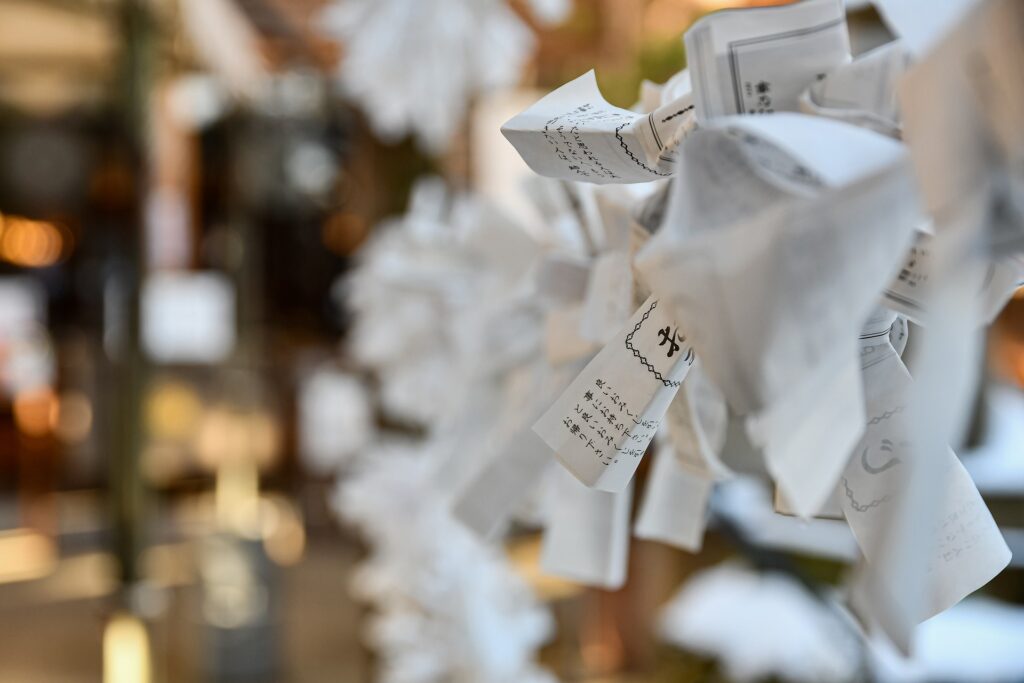Are Japanese Superstitious?
Mikuji
Japanese Fortune Telling Device Mikuji: Understanding Its Significance and How to Use It
Mikuji is a traditional Japanese fortune-telling device that is still widely used today. In Japan, it is considered to be an important part of the cultural heritage, and many people visit shrines to receive their mikuji fortunes as a form of spiritual guidance. If you are interested in learning more about this fascinating tradition, this blog post will provide you with an overview of what mikuji is and how to use it.
What is Mikuji?
Mikuji is a type of fortune-telling device that can be found at many shrines and temples in Japan. It is typically a piece of paper with a fortune written on it, and the fortunes can range from good luck to bad luck. To receive a mikuji fortune, you typically visit a shrine or temple, make a small offering, and then shake a container filled with small wooden sticks. The stick you pick will determine which fortune you receive.
The Significance of Mikuji
Mikuji is considered to be a form of divination in Japan, and it is believed to provide guidance and insight into a person’s life. Many people use mikuji as a way to gain a deeper understanding of their current situation, and to receive advice on how to move forward. The fortunes are seen as messages from the gods, and they are taken seriously by many people.
How to Use Mikuji
To use mikuji, you will first need to visit a shrine or temple that offers the service. Once you arrive, you will typically make a small offering, such as incense or a small coin, and then shake a container filled with small wooden sticks. The stick you pick will determine which fortune you receive. You can then read your fortune and see what it means.
It is important to keep in mind that mikuji is not a form of prediction, but rather a form of guidance. The fortunes you receive are not set in stone, and you have the power to change your future by taking action based on the advice you receive.
There are several types of mikuji, each with its own unique purpose and significance. Here are some of the most common types of mikuji:
- Omikuji: This is the most common type of mikuji and is the one described in the previous answer. Omikuji are typically available at shrines and temples and are used for fortune-telling purposes.
- Daimikuji: Daimikuji is a type of mikuji that is typically used for special occasions, such as weddings or birthdays. This type of mikuji is often written on a scroll and is considered to be a more formal type of mikuji.
- E-mikuji: With the rise of technology, there are now digital versions of mikuji available online. E-mikuji can be accessed through websites or smartphone apps, and they typically offer the same type of guidance and insight as traditional mikuji.
- Omamori and Ofuda: Omamori and Ofuda are similar to mikuji, but they are not typically used for fortune-telling purposes. Omamori is a type of talisman or amulet that is believed to bring good luck and protect the wearer, while Ofuda is a type of charm that is used to purify a space or protect a home.
Each type of mikuji serves a unique purpose and offers different benefits, and they are all an important part of Japanese culture and tradition. Whether you choose to use a traditional mikuji, a digital version, or one of the other types of mikuji, the guidance and insight you receive can be an invaluable tool for navigating life’s challenges and finding success.
- Conclusion
- Mikuji is a fascinating part of Japanese culture that offers insight and guidance to those who use it. Whether you are looking for spiritual guidance or simply want to experience a piece of Japanese tradition, visiting a shrine or temple to receive a mikuji fortune is a unique and enriching experience. So why not give it a try and see what your future holds!
Omamori and Ofuda: Understanding the Significance of Japanese Talismans and Charms-
Japan is a country rich in culture and tradition, and one of the most fascinating aspects of its heritage is the use of omamori and ofuda, traditional talismans and charms. These objects play an important role in Japanese spiritual and religious beliefs, and they are commonly used by those who follow Shintoism or Buddhism.
Omamori is a type of talisman that is believed to bring good luck and protect the wearer from harm. They are often carried in a small bag or hung from a purse or backpack, and they are available for a wide range of purposes, such as protection from illness, success in business, and safe travel. They are made from a variety of materials, including paper, silk, and leather, and they are often adorned with symbols or inscriptions that are thought to bring good fortune.
Ofuda, on the other hand, is a type of charm that is used to purify a space or protect a home. They are typically made of paper or wood and are inscribed with spiritual or religious symbols. They are often placed in a prominent location, such as near the front door, to help ward off evil spirits and protect the home and its occupants. Ofuda can also be used to bring peace and good luck to businesses, schools, and other institutions.
Omamori and ofuda are not only used for spiritual and religious purposes, but they are also appreciated for their beauty and craftsmanship. Many omamori and ofuda are works of art in their own right, with intricate designs and detailed inscriptions that reflect the traditions and beliefs of Japanese culture.
Whether you choose to use an omamori or ofuda, or simply appreciate the beauty and significance of these traditional objects, they are an important part of Japanese culture and spiritual heritage. By understanding their meaning and significance, you can gain a deeper appreciation for the rich cultural traditions of Japan.
In conclusion, omamori and ofuda play a significant role in Japanese spiritual and religious beliefs, and they are widely used by those who follow Shintoism or Buddhism. Whether used for protection, good luck, or simply for their beauty, these talismans and charms are an important part of Japanese culture and heritage, and they continue to hold a special place in the hearts of those who appreciate their significance.
If you’re interested in learning Japanese or exploring Japanese culture (also known as Nihon), look no further than the best Japanese institute in Jaipur. At our institute, we offer the best online classes for Japanese at all JLPT levels. Whether you’re a beginner or an advanced learner, our expert instructors can help you achieve your language learning goals.
If you have any questions about our courses or would like to learn more, please don’t hesitate to contact us anytime. You can reach out to us by calling Mr Priyanshu Sharma at 9929-51 51 51, Mrs Roopshikha Sharma at 9314502814, or Mr Akash Verma at 9001016193. Alternatively, you can visit our website at https://mydifl.com/ for further details.
Our friendly and knowledgeable team is always available to assist you in any way possible, so take advantage of the best Japanese language courses available in Jaipur and start your language learning journey today. We look forward to hearing from you soon!

